
The Uffizi Gallery is a prominent art museum located adjacent to the Piazza della Signoria in the Historic Centre of Florence in the region of Tuscany, Italy. One of the most important Italian museums and the most visited, it is also one of the largest and best-known in the world and holds a collection of priceless works, particularly from the period of the Italian Renaissance.
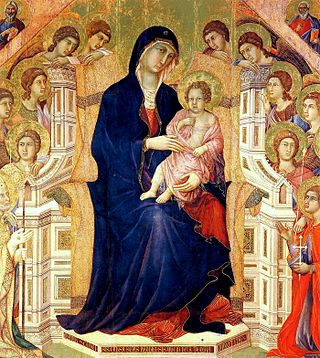
Duccio di Buoninsegna, commonly known as just Duccio, was an Italian painter active in Siena, Tuscany, in the late 13th and early 14th century. He was hired throughout his life to complete many important works in government and religious buildings around Italy. Duccio is considered one of the greatest Italian painters of the Middle Ages, and is credited with creating the painting styles of Trecento and the Sienese school. He also contributed significantly to the Sienese Gothic style.

Lorenzo di Credi was an Italian Renaissance painter and sculptor best known for his paintings of religious subjects. He is most famous for having worked in the studio of Andrea del Verrocchio at the same time as the young Leonardo da Vinci.

The Madonna Litta is a late 15th-century painting, traditionally attributed to Leonardo da Vinci, in the Hermitage Museum, Saint Petersburg. It depicts the Virgin Mary breastfeeding the Christ child, a devotional subject known as the Madonna lactans. The figures are set in a dark interior with two arched openings, as in Leonardo's earlier Madonna of the Carnation, and a mountainous landscape in aerial perspective can be seen beyond. In his left hand Christ holds a goldfinch, which is symbolic of his future Passion.

The Gemäldegalerie is an art museum in Berlin, Germany, and the museum where the main selection of paintings belonging to the Berlin State Museums is displayed. It was first opened in 1830, and the current building was completed in 1998. It is located in the Kulturforum museum district west of Potsdamer Platz.

Wilhelm von Bode was a German art historian and museum curator. Born Arnold Wilhelm Bode in Calvörde, and known as Wilhelm Bode for most of his career, he was ennobled in 1913, and thereafter adopted the aristocratic "von". He was the creator and first curator of the Kaiser Friedrich Museum, now called the Bode Museum in his honor, in 1904.

The Bode Museum, formerly called the Kaiser-Friedrich-Museum, is a listed building on the Museum Island in the historic centre of Berlin. It was built from 1898 to 1904 by order of German Emperor William II according to plans by Ernst von Ihne in Baroque Revival style. The building's front square featured a memorial to German Emperor Frederick III, which was destroyed by the East German authorities. Currently, the Bode-Museum is home to the Skulpturensammlung, the Museum für Byzantinische Kunst and the Münzkabinett. As part of the Museum Island complex, the Bode-Museum was inscribed on the UNESCO World Heritage List in 1999 because of its outstanding architecture and testimony to the development of museums as a cultural phenomenon in the late 19th and early 20th centuries.

Giovanni Antonio Boltraffio was an Italian painter of the High Renaissance from Lombardy, who worked in the studio of Leonardo da Vinci. Boltraffio and Bernardino Luini are the strongest artistic personalities to emerge from Leonardo's studio. According to Giorgio Vasari, he was of an aristocratic family and was born in Milan.
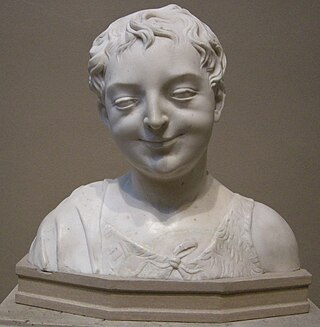
The Master of the Marble Madonnas was the name given to an unidentified sculptor, or perhaps group of sculptors, active in the Tuscan region of Italy between c. 1470 and c.1500. He is thought to have been responsible for a group of stylistically related sculptures that is based mainly on their related compositions and drapery forms. Products of the Master's workshop include a large number of reliefs of the Virgin and Child; busts and reliefs depicting the suffering of Christ were also popular, as were busts of children. Various mannerisms can be seen in this group, as well; among these has been what is described as "a peculiar feline smile from heavy-lidded eyes and a taut jaw, at its best radiating inward joy but often acerbic or bordering on the manic"
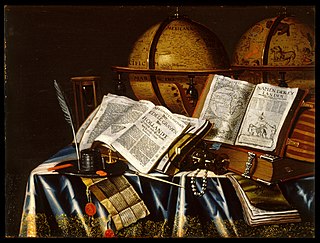
Don Marcello Massarenti, a Vatican official who helped Pope Pius IX escape from Rome at the time of the Roman republican uprising of 1849, rose to become Almoner of the Pope. In his official position he traveled extensively and amassed a collection of Italian paintings and Roman antiquities especially during the years following the Unification of Italy, when the suppression of many monastic communities and the displacement of many aristocrats from hereditary positions brought a great number of works of art onto the market in Italy, both privately and publicly. He received an honorary knighthood from Franz Josef of Austria and was decorated with the Order of the Red Eagle of Prussia.
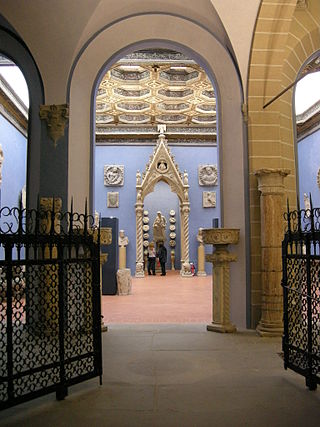
Stefano Bardini (1836–1922) was an Italian connoisseur and art dealer in Florence who specialized in Italian paintings, Renaissance sculpture, cassoni and other Renaissance and Cinquecento furnishings and architectural fragments that came on the market during the urban regeneration of Florence in the 1860s and 70s.

The Darmstadt Madonna is an oil painting by Hans Holbein the Younger. Completed in 1526 in Basel, the work shows the Bürgermeister of Basel Jakob Meyer zum Hasen, his first wife, his current wife, and his daughter grouped around the Madonna and infant Jesus.

Antonio Begarelli, also known as Begarino (1499–1565) was an Italian sculptor. In the 16th century, he was the dominant force in terracotta production in Modena.

Anatolian animal carpets represent a special type of pile-woven carpet, woven in the geographical region of Anatolia during the Seljuq and early Ottoman period, corresponding to the 14th–16th century. Very few animal-style carpets still exist today, and most of them are in a fragmentary state. Animal carpets were frequently depicted by Western European painters of the 14th–16th century. By comparison of the few surviving carpets with their painted counterparts, these paintings helped to establish a timeline of their production, and support our knowledge about the early Turkish carpet.

The Altman Madonna or 'Holy Family with St Mary Magdalene is a glue-tempera and gold on canvas painting, measuring 57.2 by 45.7 cm and dating to 1495-1505. Painted by Andrea Mantegna, it is now in the Metropolitan Museum of Art in New York.

The Pazzi Madonna is a rectangular "stiacciato" marble relief sculpture by Donatello, since 1886 in the sculpture collections of the Bode-Museum in Berlin. Dating to around 1420 and 1425 at the beginning of Donatello's collaboration with Michelozzo, it was most likely produced for private devotion and possibly commissioned by the Pazzi family for their home in Florence. The composition was very popular and is known in several copies.

The Huldschinsky Madonna is a terracotta sculpture from the beginning of the 15. century, most probably from around 1410–1415. It is attributed to Donatello, an attribution based on the structure of the drapery, which is no longer simply a means of expression and decoration as in Gothic art but is instead more naturalistic and observed from life, following a strict dialogue with the anatomical forms beneath it and obeying the rules of gravity. The work's attention to detail such as the fringes on the clothing also recalls the artist's other works such as the marble David. The sculpture was formerly painted. It has been in the Bode Museum in Berlin since being donated by Oscar Huldschinsky in 1892 in Florence, who himself never owned it.

The 'Diotallevi Madonna is an oil on panel painting by Raphael, created c. 1504. It is held in the Bode Museum, in Berlin, where it entered in 1841-1842 from Marquess Diotallevi's collection in Rimini. Previously attributed to Raphael's teacher Perugino, almost all art historians now attribute it to Raphael, with the exception of Adolfo Venturi who attributes it and parts of Perugino's Madonna della Consolazione to an anonymous "Master of the Diotallevi Madonna".
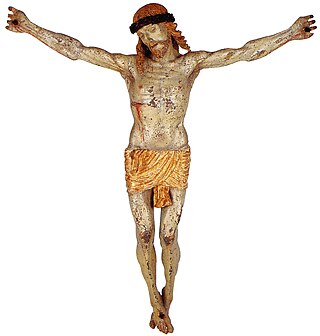
Maffeo Olivieri was an Italian sculptor and wood carver. Often associated with his younger brother Andrea, he was active in Lombardy, Venice and Trentino. He was known for his bronze, wood and marble creations, and considered the premier sculptor in early sixteenth century Brescia.

Madonna and Child with Saints is an oil on panel painting by Cima da Conegliano, created in 1504, now in the Gemäldegalerie, Berlin. From left to right the accompanying saints are Peter, Romuald, Benedict of Nursia and Paul.




















